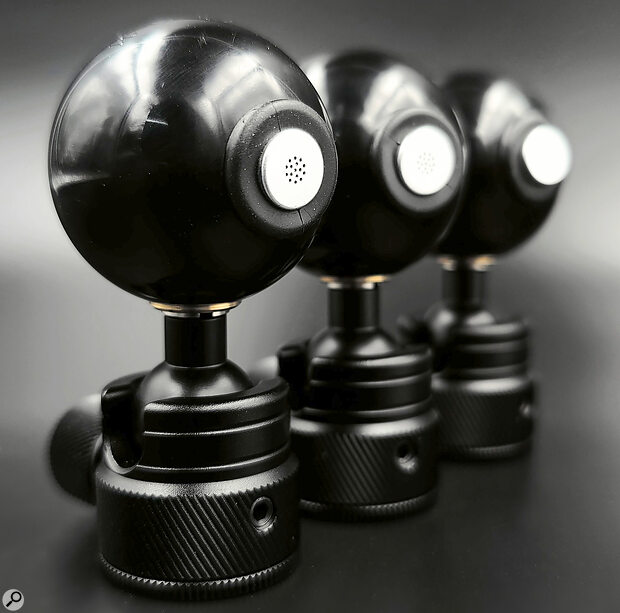This unusual‑looking microphone is designed specifically for Decca Tree arrays.
Braingasm are a specialist microphone repairer based in Rome, Italy. In addition to servicing, restoration and modification of vintage capacitor microphones (including re‑skinning capsules), the company’s lab also undertakes repairs of a wide range of outboard studio equipment, and even offers an audio electronics design service.
These days it seems quite a lot of microphone repair companies branch out into manufacturing their own microphone designs, and Braingasm are no exception, offering a small but very interesting range of studio capacitor microphones. The current portfolio includes the MP1 small‑diaphragm cardioid mic (sold in stereo pairs), along with three large‑diaphragm models: the Ferro (fixed cardioid) and Multideluxe (multi‑pattern) mics both have FET‑based impedance converters, while the Magnitude is a multi‑pattern valve microphone.
These microphones employ a range of different technologies including transformer or transformerless outputs, valve or FET impedance converters, fixed or variable polar patterns, large or small diaphragms — and so offer not only different features but also different tonalities, making each one interesting and characterful in its own unique way. Yet they are all comfortingly familiar to anyone conversant with the typical fare of standard studio microphones.
However, the subject of this review has a far less familiar format — indeed, it’s unique as far as I know! The Ocula is described as a Diffuse Field Recording System, but if that means nothing, perhaps if I say it’s available in both dual‑ and triple‑matched sets, the latter might give a better clue as to its design.
For these are compact, omnidirectional electret microphones with the capsule housed within a custom‑made Acoustic Pressure Equalising sphere (see the ‘APE Concept’ box). This configuration was first introduced in the revered Neumann M50 microphone, which has become virtually synonymous with the Decca Tree stereo technique employed widely in classical orchestral and film soundtrack recordings.
Although Neumann ceased production of the M50 in 1971, it was replaced by the TLM50 in 1990 (now discontinued) and then the M150 Tube model from 2001. The APE concept is not unique to Neumann, though, and several other manufacturers offer APE spheres as accessories for their own small‑diaphragm omnidirectional microphones. Nevertheless, the Braingasm Ocula is unique, as far as I know, in being a compact omni microphone with a permanently attached APE.
Ball Games
Pub quiz afficionados will no doubt be aware that an American pool ball is 57mm in diameter, while a British snooker ball is slightly smaller at 52.5mm. I mention this only to give a familiar reference: the shiny black Ocula microphone is a little smaller than both, having a diameter of 40mm — the same diameter as the Neumann M50 design.
Each Ocula mic weighs around 56g and has an integral 3/8‑inch threaded insert at the bottom for attaching to a mic stand. The model name and serial number are engraved onto the top of the sphere, while the audio output is carried on a fixed, 5m long (3.4mm diameter) Sommer cable exiting from the rear of the sphere. I found this cable prone to tangling, but a Velcro tie is attached to help maintain the coils in some semblance of order when stored. A genuine Neutrik XLR plug is fitted to the cable, but inside is a tiny circuit board carrying four SMD transistors and a handful of resistors and capacitors to convert between the unbalanced capsule signal and the electronically balanced XLR output. Standard 48V phantom power is required, and this is converted by the circuit board to the 3V bias required by the capsule.
 Inside the XLR barrel is a circuit board, which converts 48V phantom power into the 3V required to bias the electret capsule, and also balances the output signal.
Inside the XLR barrel is a circuit board, which converts 48V phantom power into the 3V required to bias the electret capsule, and also balances the output signal.
The capsule is mounted in a rubber grommet, with the grille slightly proud of the ball surface (presumably because the diaphragm is recessed within the electret’s metal housing). Braingasm have used a high‑quality 10mm omnidirectional electret capsule manufactured in Japan by Primo, the EM‑1272‑Z1. Specs‑wise, Braingasm’s published specs align exactly with Primo’s, stating self‑noise to...
You are reading one of the locked Subscribers-only articles from our latest 5 issues.
You've read 30% of this article for FREE, so to continue reading...
- ✅ Log in - if you have a Digital Subscription you bought from SoundOnSound.com
- ⬇️ Buy & Download this Single Article in PDF format £0.83 GBP$1.49 USD
For less than the price of a coffee, buy now and immediately download to your computer, tablet or mobile. - ⬇️ ⬇️ ⬇️ Buy & Download the FULL ISSUE PDF
Our 'full SOS magazine' for smartphone/tablet/computer. More info... - 📲 Buy a DIGITAL subscription (or 📖 📲 Print + Digital sub)
Instantly unlock ALL Premium web articles! We often release online-only content.
Visit our ShopStore.

